Related Research Articles

The Atari 2600 is a home video game console developed and produced by Atari, Inc. Released in September 1977 as the Atari Video Computer System, it popularized microprocessor-based hardware and games stored on swappable ROM cartridges, a format first used with the Fairchild Channel F in 1976. The VCS was bundled with two joystick controllers, a conjoined pair of paddle controllers, and a game cartridge—initially Combat and later Pac-Man. Sears sold the system as the Tele-Games Video Arcade. Atari rebranded the VCS as the Atari 2600 in November 1982 alongside the release of the Atari 5200.

Activision Publishing, Inc. is an American video game publisher based in Santa Monica, California. It serves as the publishing business for its parent company, Activision Blizzard, and consists of several subsidiary studios. Activision is one of the largest third-party video game publishers in the world and was the top United States publisher in 2016.
The video game crash of 1983 was a large-scale recession in the video game industry that occurred from 1983 to 1985, primarily in the United States. The crash was attributed to several factors, including market saturation in the number of video game consoles and available games, many of which were of poor quality. Waning interest in console games in favor of personal computers also played a role. Home video game revenue peaked at around $3.2 billion in 1983, then fell to around $100 million by 1985. The crash abruptly ended what is retrospectively considered the second generation of console video gaming in North America. To a lesser extent, the arcade video game market also weakened as the golden age of arcade video games came to an end.

Kaboom! is an action video game published in 1981 by Activision for the Atari 2600. The gameplay was based on the Atari arcade video game Avalanche (1978), with the game now involving a Mad Bomber who drops bombs instead of falling rocks. Kaboom! was programmed by Larry Kaplan with David Crane coding the graphics for the buckets and Mad Bomber. It was the last game designed by Kaplan for Activision, who left the company shortly after the release of the game. The game was later ported by Paul Wilson for the Atari 5200 system.
Alan Miller is an American video game designer who was the co-founder of the video game company Activision.

David Crane is an American video game designer and programmer. Crane grew up fascinated by technology and went to DeVry Institute of Technology. Following college, he went to Silicon Valley and got his first job at National Semiconductor. Through his friend Alan Miller he learned about potential video game design work at Atari, Inc. and began work there in 1977.

Imagic was an American video game developer and publisher that created games initially for the Atari 2600. Founded in 1981 by corporate alumni of Atari, Inc. and Mattel, its best-selling titles were Atlantis, Cosmic Ark, and Demon Attack. Imagic also released games for Intellivision, ColecoVision, Atari 8-bit family, TI-99/4A, IBM PCjr, VIC-20, Commodore 64, TRS-80 Color Computer, and Magnavox Odyssey². Their Odyssey² ports of Demon Attack and Atlantis were the only third-party releases for that system in America. The company never recovered from the video game crash of 1983 and was liquidated in 1986.
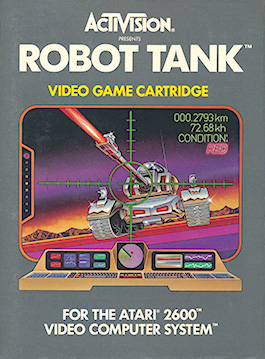
Robot Tank is a first-person shoot 'em up written by Alan Miller for the Atari 2600 and published by Activision in 1983. It is similar in design to Atari, Inc.'s Battlezone tank combat arcade video game and more so to its 2600 port. Robot Tank adds different systems which can individually be damaged—instead of the vehicle always exploding upon being shot—and weather effects.

Pitfall II: Lost Caverns is a video game developed by David Crane for the Atari 2600. It was released in 1984 by Activision. The player controls Pitfall Harry, who must explore in wilds of Peru to find the Raj Diamond, and rescue his niece Rhonda and their animal friend Quickclaw. The game world is populated by enemies and hazards that variously cause the player to lose points and return to a checkpoint.
Larry Kaplan is an American video game designer and video game programmer who, along with other ex-Atari, Inc. programmers, co-founded Activision.

Basic Math is an educational video game for the Atari Video Computer System. The game was developed at Atari, Inc. by Gary Palmer. The game involves a series of ten arithmetic problems involving addition, subtraction, multiplication, or division. The player can edit different gameplay modes to alter how the numbers in the problem are chosen, or if their questions are timed. The game was released in 1977 as one of the earliest releases for the console.

Boxing is a video game interpretation of the sport of boxing developed by programmer Bob Whitehead for the Atari VCS. It was published by Activision in 1980. It's one of the first video games developed by Activision. The game is based on Boxer, an unreleased 1978 arcade game from Whitehead's previous employer, Atari, Inc. Boxer was written by Mike Albaugh who also wrote Drag Race for Atari, a game cloned by Activision as Dragster.
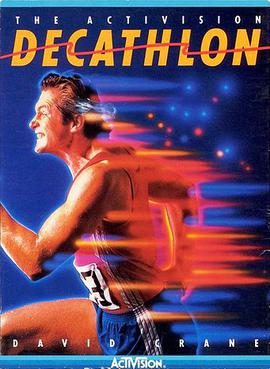
The Activision Decathlon is a sports video game written by David Crane for the Atari 2600 and published by Activision in 1983. It was ported to the Atari 8-bit computers, Atari 5200, Commodore 64, ColecoVision, and MSX. Up to four players compete in the ten different events of a real-life decathlon, either in sequence or individually.
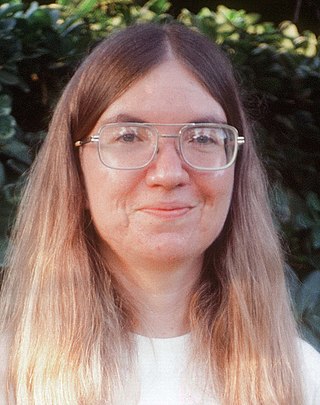
Carol Shaw is one of the first female game designers and programmers in the video game industry. She is best known for creating the Atari 2600 vertically scrolling shooter game River Raid (1982) for Activision. She worked for Atari, Inc. from 1978 to 1980, where she designed multiple games including 3-D Tic-Tac-Toe (1978) and Video Checkers (1980), both for the Atari VCS before it was renamed to the 2600. She left game development in 1984 and retired in 1990.
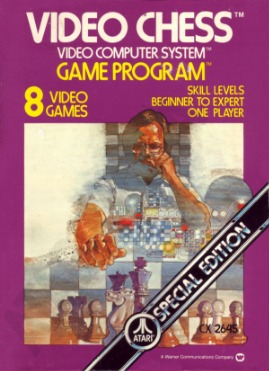
Video Chess is a chess game for the Atari VCS programmed by Larry Wagner and Bob Whitehead and released by Atari in 1979. Both programmers later developed games for Activision.

Atari, Inc. was an American video game developer and home computer company founded in 1972 by Nolan Bushnell and Ted Dabney. Atari was a key player in the formation of the video arcade and video game industry.

Street Racer is a racing video game developed for the Atari Video Computer System, later known as the Atari 2600. It was programmed by Larry Kaplan and released by Atari, Inc. in September 1977 as one of the nine Atari VCS launch titles. The game was also published by Sears for their Tele-Games product line as Speedway II.

Absolute Entertainment was an American video game publishing company. Through its development house, Imagineering, Absolute Entertainment produced titles for the Atari 2600, Atari 7800, Game Gear, Genesis/Mega Drive, Sega CD, Game Boy, Nintendo Entertainment System, and Super Nintendo Entertainment System video game consoles, as well as for the Commodore 64, Apple II, and IBM PC compatibles.

Video Checkers is a video game developed and published by Atari, Inc. in 1980 for the Atari VCS, renamed to Atari 2600.
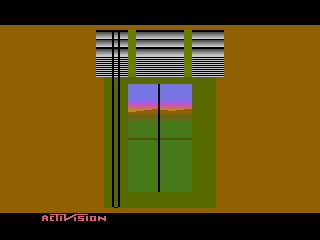
Venetian Blinds is a simulation video game developed by Activision co-founders David Crane and Bob Whitehead for the Atari 2600. The game simulates the raising and lowering of Venetian blinds on a window, and was facetiously presented as a technology demonstration of Whitehead's graphical programming technique of the same name, although it does not use the technique.
References
- 1 2 3 4 5 6 Interview with Bob Whitehead from DigitPress.com
- ↑ Flemming, Jeffrey (July 30, 2007). "The History Of Activision". Gamasutra . Archived from the original on August 19, 2019. Retrieved September 27, 2019.
- ↑ "Operating System sources". XL Addendum - Atari Home Computer System - Operating System Manual - Supplement to ATARI 400/800 Technical Reference Notes (PDF). Atari, Inc. 1984. OS listing p.1. Retrieved September 27, 2019.
- ↑ Thomasson, Michael (n.d.). "INTERVIEW - David Crane". Good Deal Games.
There is a period at Atari when there were no games coming from Larry Kaplan, Alan Miller, Bob Whitehead, and myself. As the most senior designers at Atari we were tasked with creating the 800 operating system. This group, plus two others, wrote the entire operating system in about 8 months.
- ↑ Kindig, Randy; Savetz, Kevin; Arnold, Brad (February 25, 2016) [Conducted October 23, 2015]. "ANTIC Interview 136 - David Crane, Pitfall!, Atari 400/800 OS". ANTIC The Atari 8-bit Podcast (Podcast). Event occurs at 15:56. Retrieved September 27, 2019.
You know we had a - I guess that we had the four of us - Larry Kaplan, Al Miller, Bob Whitehead and myself; we had a couple of contractors who were brought in who had done communications with hard drives and things, floppy disks, things like that.
- ↑ Decuir, Joe (May 6, 2019) [Recorded May 5, 2019]. Atari 800 Series Computers: 40 Years. Vintage Computer Festival East 2019. Event occurs at 1:12:36. Archived from the original on December 14, 2021. Retrieved September 27, 2019.
BIOS Software: Al Miller, David Crane, Larry Kaplan, Bob Whitehead & Howard Bornstein
{{cite AV media}}: CS1 maint: location (link) - ↑ Saunders, Glenn (1997). "Tape 08 - David Crane, Al Miller". Stella at 20 - An Atari 2600 Retrospective. Event occurs at 4:45. Retrieved September 27, 2019.
So there's this one year period where Atari actually took its most productive VCS programmers and put them on the 400/800 computer. I'd say most productive with the exception of Bob [Whitehead] - Bob continued to work on VCS carts.
- ↑ Digital Press Interviews
- ↑ "Atari Compendium".
- ↑ "Atari Compendium".